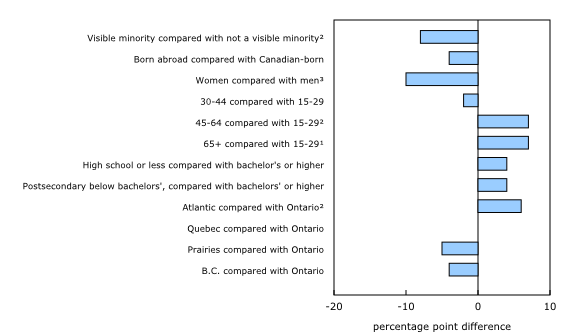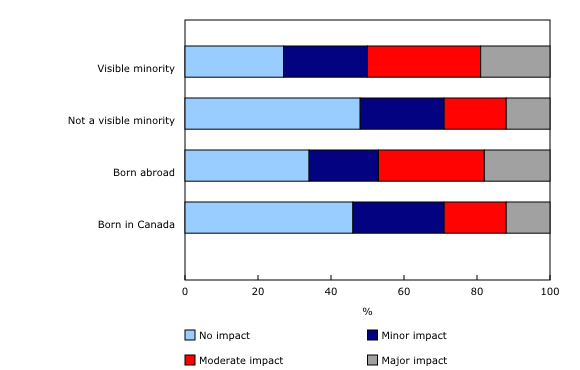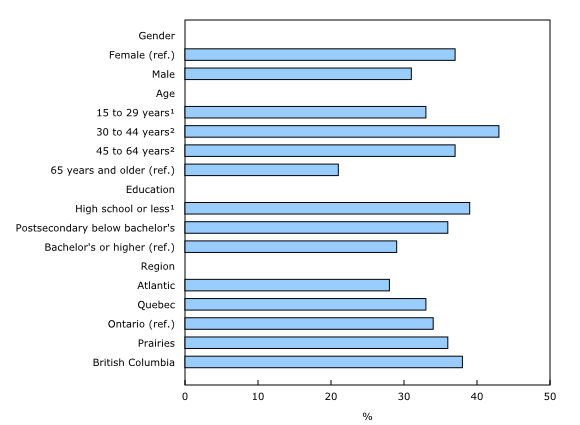Portrait of Canadian Society: Experiences during the pandemic
Archived Content
Information identified as archived is provided for reference, research or recordkeeping purposes. It is not subject to the Government of Canada Web Standards and has not been altered or updated since it was archived. Please "contact us" to request a format other than those available.
Released: 2021-09-27
The COVID-19 pandemic impacted peoples' lives in a multitude of ways, affecting their health, livelihoods, and social connections. It also affected the social fabric of society and made people reconsider their sense of community.
To examine how the pandemic influenced Canadians' views on their communities and affected their economic and financial situation, Statistics Canada conducted its second survey from the Portrait of Canadian Society series (PCS2) from July 19 to August 1, 2021. The survey covers the experiences of the Canadian population during the first 16 months of the pandemic.
This study highlights the social and economic impacts of the pandemic on groups designated as visible minorities and those born abroad. The results show that during the pandemic, these populations have seen their communities as being less inclusive and consider their neighbourhoods less safe for people with a different skin colour, ethnic origin or religion. They have also reported more of an impact on their financial situation and their ability to meet essential needs compared with other Canadians.
While most Canadians report living in an inclusive community, visible minorities and those born outside Canada are less likely to feel this way
An inclusive community is one where people can participate in activities without fear of experiencing harassment or discrimination. Most Canadians (86%) reported living in inclusive communities during the pandemic, and the results showed no statistically significant differences in the perception of inclusiveness of their community by gender, age group, or highest level of education of respondent.
However, persons designated as visible minorities and those born abroad saw their communities as less inclusive during the pandemic. For example, 81% of the visible minority population described their community as inclusive, while 87% of those not designated as a visible minority did so. Similarly, 81% of people born abroad felt their community was inclusive compared with 88% of those born in Canada. This difference became even greater when the results were adjusted for the effects of gender, age group, education and the respondent's region of residence.
Persons designated as visible minorities consider their neighbourhoods less safe for people with different skin colour, ethnic origin or religion
In addition to inclusiveness of their communities, survey respondents were asked how often they think people in their neighbourhood had been harassed or attacked because of their skin colour, ethnic origin or religion since the start of the pandemic. Overall, 13% of Canadians reported that people in their neighbourhood had often or sometimes been targeted for these reasons.
While the majority of Canadians (87%) did not consider their communities as unsafe to others, there were important differences. Chart 1 illustrates the percentage differences in perceiving neighbourhoods as safe by such social characteristics as visible minority status, place of birth, gender, age group, education and region of residence. It shows that visible minorities were less likely to see their neighbourhoods as safe for people of different skin colour, ethnic origin or religion compared with those who were not a visible minority (80% versus 88%).
Perception of safety in neighbourhoods also differed by gender, age group, and the respondent's region of residence. Women considered their communities less friendly to people of diverse origins than men (82% vs. 92%), as did younger people (aged 15 to 29) compared with those aged 45 to 64 (83% vs. 91%). Residents of the Atlantic provinces saw their neighbourhoods as safer compared with residents of Ontario (93% vs. 87%).
People designated as visible minorities or born outside Canada report more financial impacts due to the pandemic
The COVID-19 pandemic poses strong challenges to the financial situation of many Canadians, but is having a particular impact on the economic participation and well-being of visible minorities and immigrants. These Canadians, many of whom work in the industries and essential services most often affected by the pandemic, have experienced unemployment, job change and economic uncertainty.
Throughout the pandemic, the unemployment rates of visible minorities remained higher than those of other Canadians (see COVID-19 in Canada: A One-year Update on Social and Economic Impacts). Immigrants and visible minorities, like other groups with higher levels of poverty and economic vulnerability, were also more likely to rely on the Canada Emergency Response Benefit (see Workers receiving payments from the Canada Emergency Response Benefit program in 2020).
Reflecting this situation, the PCS2 survey found that Canadians designated as visible minorities or born outside the country were significantly more likely than other Canadians to state that COVID-19 had a major impact on their ability to meet financial obligations or essential needs, such as rent or mortgage payments, utilities and groceries. Also, a considerably smaller proportion among Canadians designated as visible minorities or born outside the country reported being untouched by the pandemic in financial terms.
For example, just over one-quarter (27%) of those designated as visible minorities and just over one-third (34%) of those born outside Canada stated that the pandemic had no impact on their financial situation, compared with almost one-half of respondents who were not visible minorities (48%) or who were born in Canada (46%).
Just over one-half of visible minorities (51%) and almost half of those born abroad (47%) reported a major or moderate financial impact of the pandemic, compared with 29% of those in the reference categories. These differences remained significantly large after adjusting the results by gender, age group, education and region of residence.
In addition to affecting Canadians designated as visible minorities and those born abroad, the pandemic has had a greater impact on the financial situation of adults of working age and those with lower levels of education.
For instance, twice as many Canadians in the 30-to-44 age group (43%) reported major or moderate financial impacts of the pandemic, compared with 21% of those of retirement age (65 years and older). Meanwhile, 39% of those with a high school diploma or less reported financial difficulties during the pandemic, compared with 29% of those with a bachelors' degree or higher.
The financial hardships of these and other Canadians resulted from the rise of unemployment and job losses associated with the pandemic, and tested the financial resilience of their households (see The financial resilience and financial well-being of Canadians during the COVID-19 pandemic).
Note to readers
The data in this release are from the second survey of Statistics Canada's survey series named Portrait of Canadian Society (PCS). The PCS survey series is a brand-new project put forward by Statistics Canada. The project consists of four very short online surveys given to the same respondents over a period of one year. These voluntary surveys use a probability panel based on the General Social Survey – Social Identity and are therefore representative of the Canadian population aged 15 years and over.
The PCS survey series are part of Statistics Canada's modernization efforts and are at a pilot stage. This collection method will be refined over time. For this study, survey weights were adjusted to minimize potential bias that could arise from panel non-response. Non-response adjustments and calibration using available auxiliary information were applied and are reflected in the survey weights provided with the data file. Despite these adjustments, the high degree of non-response to the panel increases the risk of remaining bias, which may impact estimates produced using the panel data. Users should consult the accompanying guide for data quality guidelines and considerations.
The first survey in the PCS survey series, which looked at perceptions of life during the pandemic, collected data on Canadians' mental and general health, physical activity, life satisfaction and view of the future.
The second PCS survey (PCS2) collected data on employment, employment benefits and training, access to healthcare and intent to vaccinate, perceptions of safety, financial impact of the pandemic and expectations about the future. In this study, the sample size does not support analysis for individual visible minority groups or gender diverse populations.
The aim of the series is to fully understand the needs of communities, in order to implement suitable support measures during and after the COVID-19 pandemic. Statistics Canada would like to thank all Canadians who took the time to answer the questions during this time of crisis.
Contact information
For more information, or to enquire about the concepts, methods or data quality of this release, contact us (toll-free 1-800-263-1136; 514-283-8300; STATCAN.infostats-infostats.STATCAN@canada.ca) or Media Relations (613-951-4636; STATCAN.mediahotline-ligneinfomedias.STATCAN@canada.ca).
- Date modified:




